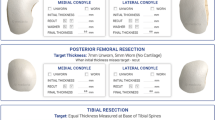Abstract
Purpose
Kinematically aligned total knee arthroplasty (TKA) positions the femoral component at the natural angle and level of the distal (0°) and posterior (90°) joint line. This technique applies referencing guides at 0° and 90° that are adjusted to compensate for wear and kerf and perform resections equal in thickness to the femoral component. Knowing whether femoral bone and cartilage wear is predictable would assist in establishing general guidelines for adjusting the resection level of these two referencing guides. This study tests the hypothesis that femoral bone and cartilage wear is predictable at 0° and 90° in the varus and valgus osteoarthritic knee treated with TKA.
Methods
The study consists of 205 patients and 208 knees with Kellgren–Lawrence Grade 3 or 4 osteoarthritis and treated with a TKA. Each knee had a narrow slice (2 mm) preoperative 1.5 tesla magnetic resonance image in the sagittal plane. Femoral bone and cartilage wear at 0° and 90° was computed from best-fit circles superimposed on the peripheral boundary of the subchondral bone on the medial and lateral femoral condyles.
Results
Overall, 99.5 % of knees had minimal bone wear (<1 mm) at 0° and 90°. In the 74 % (154 of 208) of knees with a varus deformity, 92 % at 0° and 2 % at 90° had >1 mm cartilage wear on the medial femoral condyle. In the 26 % (54 of 208) of knees with a valgus deformity, 78 % at 0° and 55 % at 90° had ≥1 mm cartilage wear on the lateral femoral condyle.
Conclusions
As a general guideline, adjustment for femoral bone wear is rarely required when performing kinematically aligned TKA. Most osteoarthritic knees require adjustment of the distal referencing guide to compensate for cartilage wear on the medial femoral condyle in the varus knee and the lateral femoral condyle in the valgus knee. Adjustment of the posterior referencing guide is required in about half of valgus osteoarthritic knees to compensate for lateral cartilage wear at 90°. Knowing that bone wear is rare and cartilage wear is predictable in varus and valgus Kellgren–Lawrence Grade 3 or 4 osteoarthritic knees helps establish general guidelines for adjusting the distal and posterior femoral referencing guides to restore the natural angle and level of the femoral joint lines when performing kinematically aligned TKA with generic instruments.
Level of evidence
IV.






Similar content being viewed by others
References
Bellemans J, Colyn W, Vandenneucker H, Victor J (2012) The Chitranjan Ranawat award: is neutral mechanical alignment normal for all patients? The concept of constitutional varus. Clin Orthop Relat Res 470(1):45–53
Dossett HG, Swartz GJ, Estrada NA, LeFevre GW, Kwasman BG (2012) Kinematically versus mechanically aligned total knee arthroplasty. Orthopedics 35:e160–e169
Eckhoff DG, Bach JM, Spitzer VM, Reinig KD, Bagur MM, Baldini TH, Flannery NM (2005) Three-dimensional mechanics, kinematics, and morphology of the knee viewed in virtual reality. J Bone Joint Surg Am 87(Suppl 2):71–80
Eckstein F, Kwoh CK, Boudreau RM, Wang Z, Hannon MJ, Cotofana S, Hudelmaier MI, Wirth W, Guermazi A, Nevitt MC, John MR, Hunter DJ, Investigators OAI (2013) Quantitative MRI measures of cartilage predict knee replacement: a case-control study from the Osteoarthritis Initiative. Ann Rheum Dis 72:707–714
Frobell RB, Nevitt MC, Hudelmaier M, Wirth W, Wyman BT, Benichou O, Dreher D, Davies R, Lee JH, Baribaud F, Gimona A, Eckstein F, Osteoarthritis Initiative Investigators (2010) Femorotibial subchondral bone area and regional cartilage thickness: a cross-sectional description in healthy reference cases and various radiographic stages of osteoarthritis in 1,003 knees from the Osteoarthritis Initiative. Arthritis Care Res (Hoboken) 62:1612–1623
Hollister AM, Jatana S, Singh AK, Sullivan WW, Lupichuk AG (1993) The axes of rotation of the knee. Clin Orthop Relat Res 290:259–268
Howell SM, Howell SJ, Kuznik KT, Cohen J, Hull ML (2013) Does a kinematically aligned total knee arthroplasty restore function without failure regardless of alignment category? Clin Orthop Relat Res 471(3):1000–1007
Howell SM, Papadopoulos S, Kuznik KT, Hull ML (2013) Accurate alignment and high function after kinematically aligned TKA performed with generic instruments. Knee Surg Sports Traumatol Arthrosc 21:2271–2280
Howell SM, Howell SJ, Hull ML (2010) Assessment of the radii of the medial and lateral femoral condyles in varus and valgus knees with osteoarthritis. J Bone Joint Surg Am 92:98–104
Kalairajah Y, Azurza K, Hulme C, Molloy S, Drabu KJ (2005) Health outcome measures in the evaluation of total hip arthroplasties—a comparison between the Harris hip score and the Oxford hip score. J Arthroplasty 20:1037–1041
Li H, Hosseini A, Li JS, Gill TJ IV, Li G (2012) Quantitative magnetic resonance imaging (MRI) morphological analysis of knee cartilage in healthy and anterior cruciate ligament-injured knees. Knee Surg Sports Traumatol Arthrosc 20:1496–1502
Tashiro Y, Uemura M, Matsuda S, Okazaki K, Kawahara S, Hashizume M, Iwamoto Y (2012) Articular cartilage of the posterior condyle can affect rotational alignment in total knee arthroplasty. Knee Surg Sports Traumatol Arthrosc 20:1463–1469
Vanlommel L, Vanlommel J, Claes S, Bellemans J (2013) Slight undercorrection following total knee arthroplasty results in superior clinical outcomes in varus knees. Knee Surg Sports Traumatol Arthrosc 21(10):2325–2330
Victor JM, Bassens D, Bellemans J, Gursu S, Dhollander AA, Verdonk PC (2013) Constitutional varus does not affect joint line orientation in the coronal plane. Clin Orthop Relat Res 472(1):98–104
Author information
Authors and Affiliations
Corresponding author
Rights and permissions
About this article
Cite this article
Nam, D., Lin, K.M., Howell, S.M. et al. Femoral bone and cartilage wear is predictable at 0° and 90° in the osteoarthritic knee treated with total knee arthroplasty. Knee Surg Sports Traumatol Arthrosc 22, 2975–2981 (2014). https://doi.org/10.1007/s00167-014-3080-8
Received:
Accepted:
Published:
Issue Date:
DOI: https://doi.org/10.1007/s00167-014-3080-8




